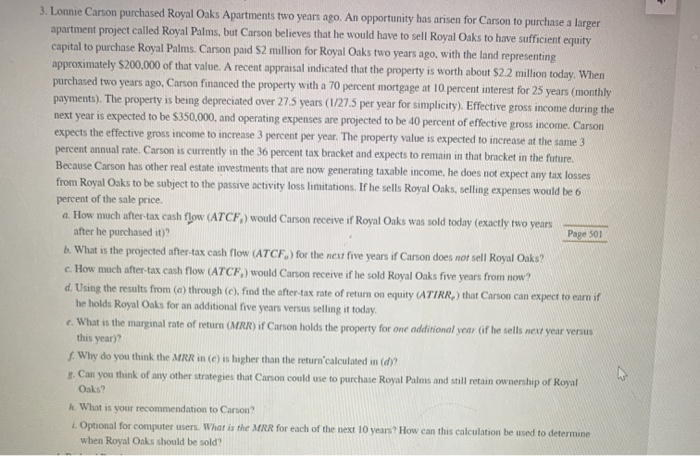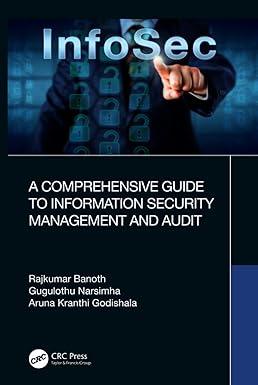
3. Lonnie Carson purchased Royal Oaks Apartments two years ago. An opportunity has arisen for Carson to purchase a larger apartment project called Royal Palms, but Carson believes that he would have to sell Royal Oaks to have sufficient equity capital to purchase Royal Palms. Carson paid $2 million for Royal Oaks two years ago, with the land representing approximately $200,000 of that value. A recent appraisal indicated that the property is worth about $2.2 million today. When purchased two years ago, Carson financed the property with a 70 percent mortgage at 10 percent interest for 25 years (monthly payments). The property is being depreciated over 27.5 years (1/27.5 per year for simplicity). Effective gross income during the next year is expected to be $350,000, and operating expenses are projected to be 40 percent of effective gross income. Carson expects the effective gross income to increase 3 percent per year. The property value is expected to increase at the same 3 percent annual rate. Carson is currently in the 36 percent tax bracket and expects to remain in that bracket in the future. Because Carson has other real estate investments that are now generating taxable income, he does not expect any tax losses from Royal Oaks to be subject to the passive activity loss limitations. If he sells Royal Oaks, selling expenses would be 6 percent of the sale price. a. How much after-tax cash flow (ATCF) would Carson receive if Royal Oaks was sold today (exactly two years Page 501 after he purchased it)? b. What is the projected after-tax cash flow (ATCF.) for the next five years if Carson does not sell Royal Oaks? c. How much after-tax cash flow (ATCF) would Carson receive if he sold Royal Oaks five years from now? d. Using the results from (a) through (c).find the after-tax rate of return on equity ATIRR.) that Carson can expect to earn if he holds Royal Oaks for an additional five years versus selling it today, c. What is the marginal rate of return (MRR) if Carson holds the property for one additional year (if he sells next year versus this year) f. Why do you think the MRR in () is higher than the return calculated in (d)? . Can you think of any other strategies that Carson could use to purchase Royal Palms and still retain ownership of Royal Oaks? 1. What is your recommendation to Carson? 1. Optional for computer users. What is the MRR for each of the next 10 years? How can this calculation be used to determine when Royal Oaks should be sold? 3. Lonnie Carson purchased Royal Oaks Apartments two years ago. An opportunity has arisen for Carson to purchase a larger apartment project called Royal Palms, but Carson believes that he would have to sell Royal Oaks to have sufficient equity capital to purchase Royal Palms. Carson paid $2 million for Royal Oaks two years ago, with the land representing approximately $200,000 of that value. A recent appraisal indicated that the property is worth about $2.2 million today. When purchased two years ago, Carson financed the property with a 70 percent mortgage at 10 percent interest for 25 years (monthly payments). The property is being depreciated over 27.5 years (1/27.5 per year for simplicity). Effective gross income during the next year is expected to be $350,000, and operating expenses are projected to be 40 percent of effective gross income. Carson expects the effective gross income to increase 3 percent per year. The property value is expected to increase at the same 3 percent annual rate. Carson is currently in the 36 percent tax bracket and expects to remain in that bracket in the future. Because Carson has other real estate investments that are now generating taxable income, he does not expect any tax losses from Royal Oaks to be subject to the passive activity loss limitations. If he sells Royal Oaks, selling expenses would be 6 percent of the sale price. a. How much after-tax cash flow (ATCF) would Carson receive if Royal Oaks was sold today (exactly two years Page 501 after he purchased it)? b. What is the projected after-tax cash flow (ATCF.) for the next five years if Carson does not sell Royal Oaks? c. How much after-tax cash flow (ATCF) would Carson receive if he sold Royal Oaks five years from now? d. Using the results from (a) through (c).find the after-tax rate of return on equity ATIRR.) that Carson can expect to earn if he holds Royal Oaks for an additional five years versus selling it today, c. What is the marginal rate of return (MRR) if Carson holds the property for one additional year (if he sells next year versus this year) f. Why do you think the MRR in () is higher than the return calculated in (d)? . Can you think of any other strategies that Carson could use to purchase Royal Palms and still retain ownership of Royal Oaks? 1. What is your recommendation to Carson? 1. Optional for computer users. What is the MRR for each of the next 10 years? How can this calculation be used to determine when Royal Oaks should be sold







